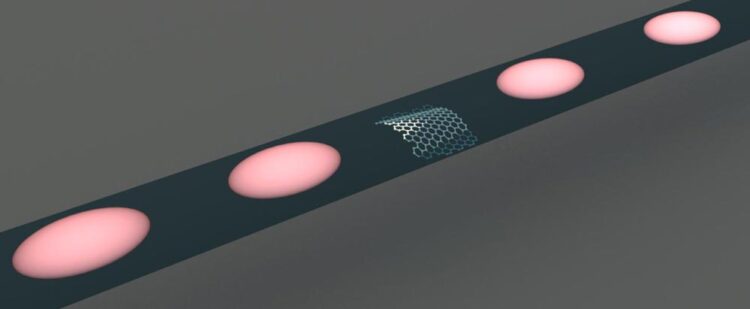Researchers develop light emitters for quantum circuits

A closer look at the single photon emitter designed by researchers in Sweden.
Credit: Ali Elshaair
The promise of a quantum internet depends on the complexities of harnessing light to transmit quantum information over fiber optic networks. A potential step forward was reported today by researchers in Sweden who developed integrated chips that can generate light particles on demand and without the need for extreme refrigeration.
Quantum computing today relies on states of matter, that is, electrons which carry qubits of information to perform multiple calculations simultaneously, in a fraction of the time it takes with classical computing.
The co-author of the research, Val Zwiller, Professor at KTH Royal Institute of Technology, says that in order to integrate quantum computing seamlessly with fiber-optic networks–which are used by the internet today–a more promising approach would be to harness optical photons.
“The photonic approach offers a natural link between communication and computation,” he says. “That’s important, since the end goal is to transmit the processed quantum information using light.”
But in order for photons to deliver qubits on-demand in quantum systems, they need to be emitted in a deterministic, rather than probabilistic, fashion. This can be accomplished at extremely low temperatures in artificial atoms, but today the research group at KTH reported a way to make it work in optical integrated circuits–at room temperature.
The new method enables photon emitters to be precisely positioned in integrated optical circuits that resemble copper wires for electricity, except that they carry light instead, says co-author of the research, Ali Elshaari, Associate Professor at KTH Royal Institute of Technology.
The researchers harnessed the single-photon-emitting properties of hexagonal boron nitride (hBN), a layered material. hBN is a compound commonly used is used ceramics, alloys, resins, plastics and rubbers to give them self-lubricating properties. They integrated the material with silicon nitride waveguides to direct the emitted photons.
Quantum circuits with light are either operated at cryogenic temperatures–plus 4 Kelvin above absolute zero–using atom-like single photon sources, or at room temperature using random single photon sources, Elshaari says. By contrast, the technique developed at KTH enables optical circuits with on-demand emission of light particles at room temperature.
“In existing optical circuits operating at room temperature, you never know when the single photon is generated unless you do a heralding measurement,” Elshaari says. “We realized a deterministic process that precisely positions light-particles emitters operating at room temperature in an integrated photonic circuit.”
The researchers reported coupling of hBN single photon emitter to silicon nitride waveguides, and they developed a method to image the quantum emitters. Then in a hybrid approach, the team built the photonic circuits with respect to the quantum sources locations using a series of steps involving electron beam lithography and etching, while still preserving the high quality nature of the quantum light.
The achievement opens a path to hybrid integration, that is, incorporating atom-like single-photon emitters into photonic platforms that cannot emit light efficiently on demand.
All latest news from the category: Information Technology
Here you can find a summary of innovations in the fields of information and data processing and up-to-date developments on IT equipment and hardware.
This area covers topics such as IT services, IT architectures, IT management and telecommunications.
Newest articles

Innovative 3D printed scaffolds offer new hope for bone healing
Researchers at the Institute for Bioengineering of Catalonia have developed novel 3D printed PLA-CaP scaffolds that promote blood vessel formation, ensuring better healing and regeneration of bone tissue. Bone is…

The surprising role of gut infection in Alzheimer’s disease
ASU- and Banner Alzheimer’s Institute-led study implicates link between a common virus and the disease, which travels from the gut to the brain and may be a target for antiviral…

Molecular gardening: New enzymes discovered for protein modification pruning
How deubiquitinases USP53 and USP54 cleave long polyubiquitin chains and how the former is linked to liver disease in children. Deubiquitinases (DUBs) are enzymes used by cells to trim protein…



